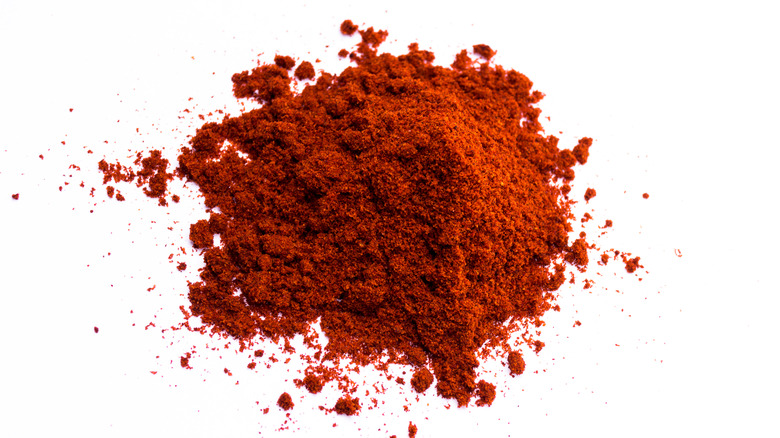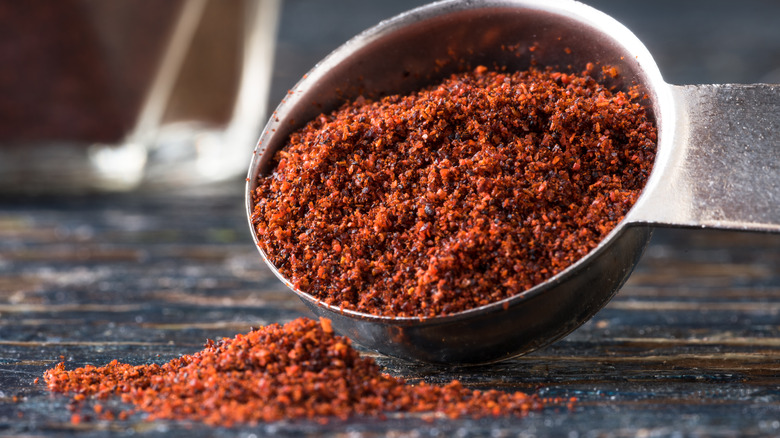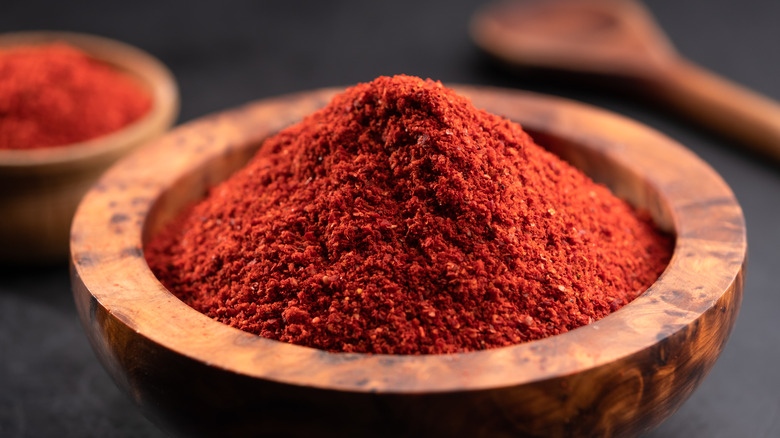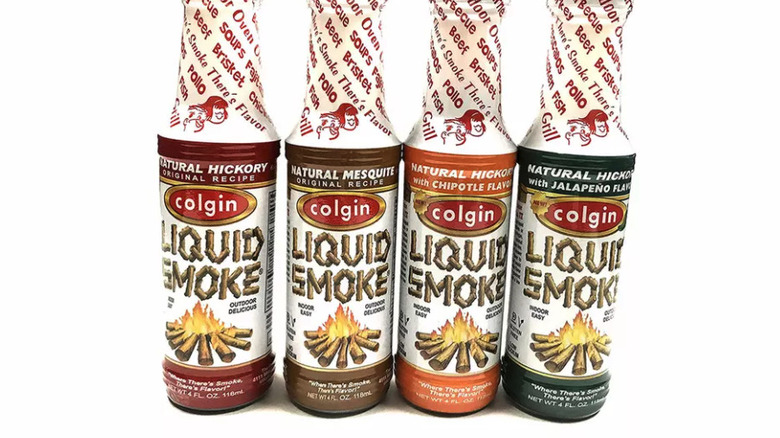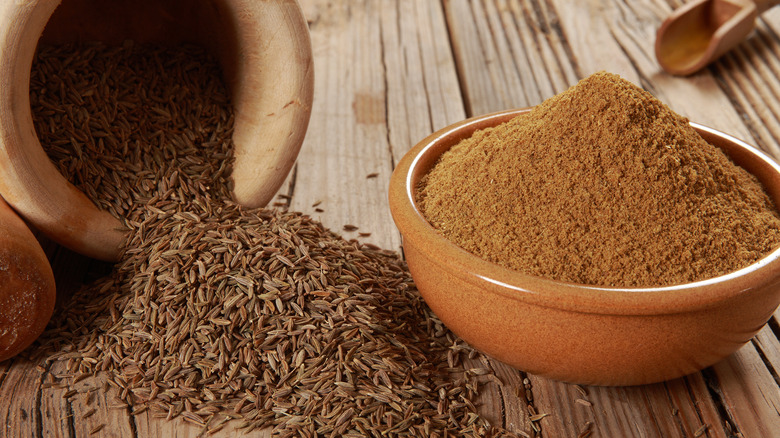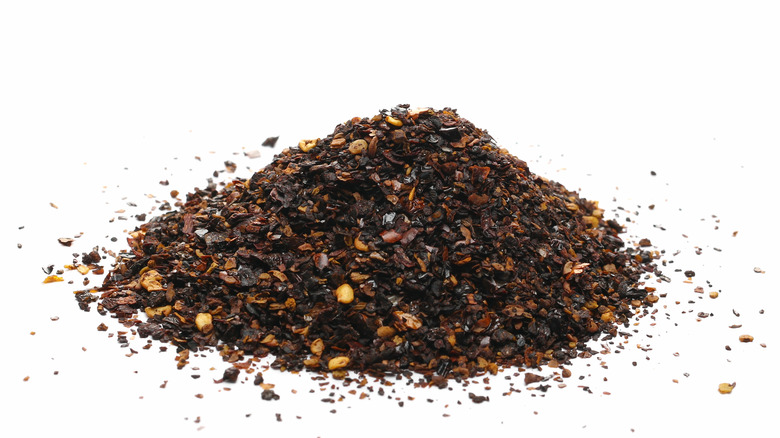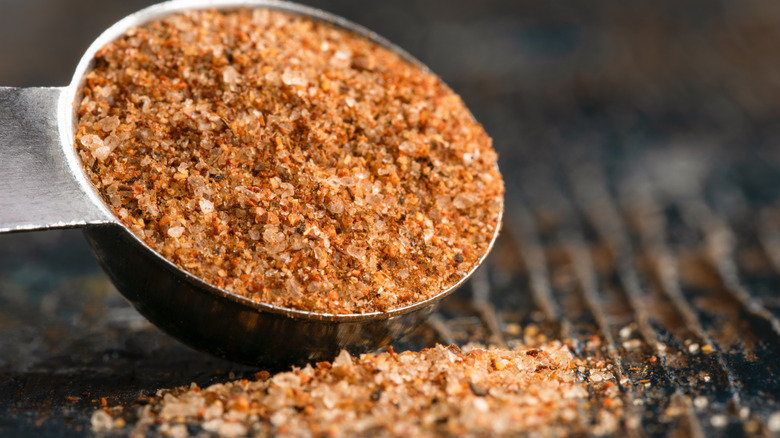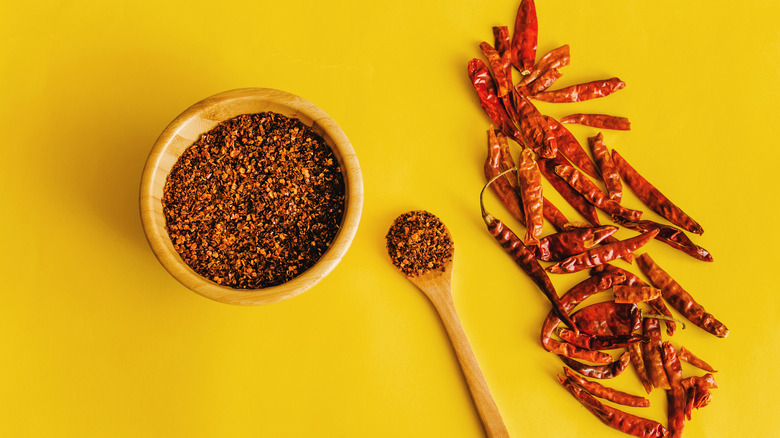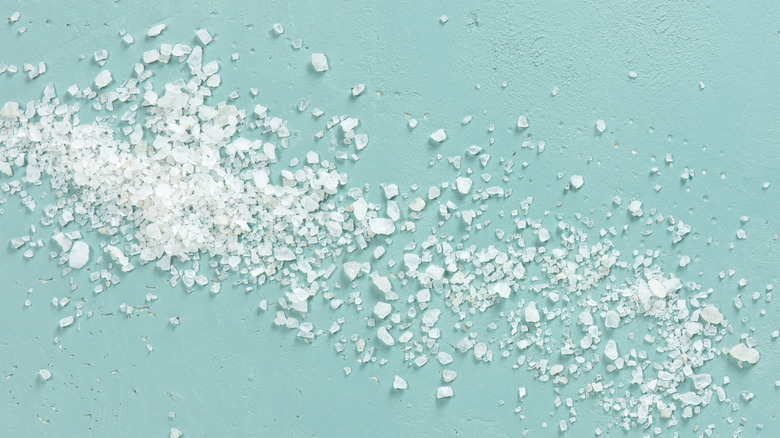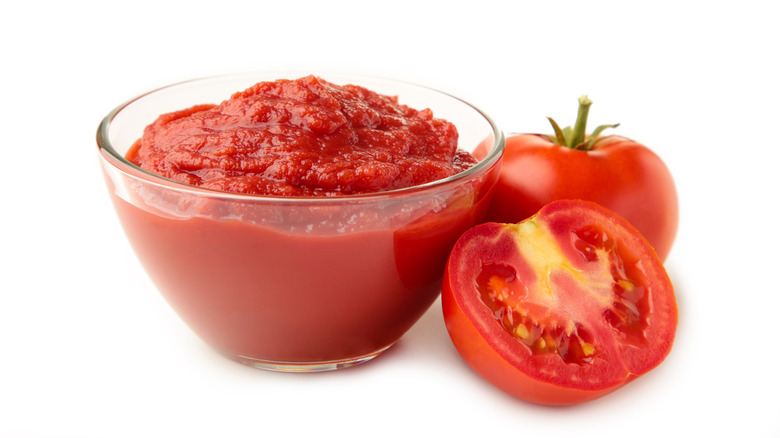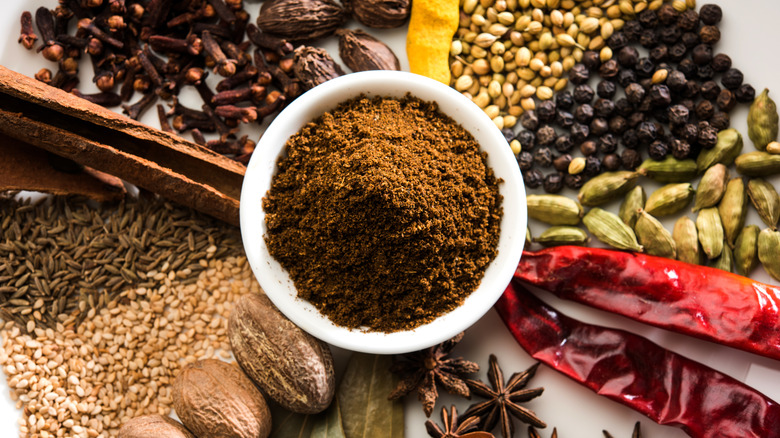10 Best Substitutes For Smoked Paprika
For any home cook, a good spice collection is an integral part of creating incredible, flavor-packed dishes. Whether you prefer to make your own seasoning blends from solitary spices or you incorporate a few store-bought blends into the mix, there's no denying that spices and seasonings can take an incredibly simple dish from boring and bland to absolutely delicious. And when it comes to stocking your spice cabinet, there's one spice you don't want to forget: smoked paprika.
Many cooks have regular paprika in their spice collection and may not want to add a second jar of what they think is roughly the same ingredient, but don't make that mistake. Smoked paprika does contain the same trademark bright red hue that adds some serious color to your dish, as well as the same complex flavor, that regular paprika does. The big difference is that it's treated by, well, smoking, meaning it brings those smoky flavor notes to whatever you use it on as well. The complexity of flavor means this spice is a fun one to experiment with, as you can use it either when you want those smoky notes or when you want that signature paprika flavor.
If you find yourself interested in a recipe that calls for smoked paprika and you don't yet have it in your spice collection, though, there are a few great substitutes that can work in your dish.
1. Chipotle Powder
If those smoky flavor notes are one of the most important parts of the smoked paprika inclusion in a recipe, one of the best substitutes is chipotle powder (via PepperScale). Chipotle powder is crafted from smoked chilies, just like paprika is, and packs in that smoky flavor as well as a hint of earthiness that can add some serious complexity to your dish.
The one thing to note if making this substitution is that chipotle powder typically contains a lot more heat than smoked paprika. While smoked hot paprika and smoked sweet paprika both exist, in most recipes smoked paprika refers to a smoked version of regular paprika. So, you'll want to be mindful of the heat levels in your final dish if using chipotle powder.
The color is also a bit different — while including a generous amount of paprika will dye any dish a vibrant orange-red hue, chipotle powder adds a deeper, darker red coloring to your dish. For best results, you can make a direct substitution. So for every tablespoon of smoked paprika your recipe calls for, you would add a tablespoon of chipotle powder.
2. Regular Paprika
If all you have on hand is regular paprika, don't fret — the many similarities between regular paprika and smoked paprika mean that it's a strong substitute (via The Stone Soup). After all, they're the exact same spice; smoked paprika simply has an extra step in the processing that infuses the smokiness into the seasoning. Using regular paprika as a substitute will still deliver that incredible paprika flavor to whatever dish you use it in and will also add that same vibrant color.
This substitute is particularly well-suited to ingredients where the overall appearance of your spice matters, such as a sprinkle of paprika atop deviled eggs. The only downside is that, obviously, regular paprika doesn't have those same smoky flavor notes. However, your final dish will still be very flavorful with this substitution.
Make sure to read the label of your paprika carefully, too. There are hot and sweet versions of paprika, and each add some unique flavor notes that you'll want to be mindful of. For best results, you can do a one-to-one swap. So, for every tablespoon of smoked paprika your dish calls for, you would include a tablespoon of regular paprika instead.
3. Liquid Smoke
If you're making something where you feel the smokiness is absolutely integral to the overall flavor profile of the dish, an ideal substitute for smoked paprika is liquid smoke (via A Couple Cooks). This unique seasoning is made when wood is burned, and the byproduct of that process is distilled and filtered to create a powerful flavoring agent that infuses a huge punch of smoky flavor without having to stick your meal in a smoker.
Liquid smoke comes in a variety of flavors depending on what type of wood was burned, from hickory to applewood to mesquite, and you'll want to consider the general flavor profile of whatever type of liquid smoke you choose when making this substitution. You won't get the bold red hue characteristic of paprika, and you also won't get any of the paprika flavor notes you may love — all you're adding is a healthy dose of that smoky flavor. However, for certain dishes, that may be exactly what you need.
The primary thing to be careful of when substituting liquid smoke is the amount. It's quite a strong flavor and can overpower your dish if you add a dash too much, so for best results, you'll want to reduce the amount you use. So, if your recipe calls for a teaspoon of smoked paprika, you would add a half teaspoon of liquid smoke as a substitution.
4. Cumin
While you might add cumin with a heavy hand to Mexican dishes, it doesn't seem like the most natural substitute for smoked paprika. However, you'd be surprised at how well it does in a swap (via The Stone Soup). Cumin has a lot of earthy flavor notes that mimic what you'd find in smoked paprika, as well as a hint of smokiness. It has a different overall flavor, and the two likely wouldn't seem that alike if you did a side-by-side taste test, but both spices bring similar qualities to a finished dish that makes this common spice a decent substitute.
One thing to be aware of is the color. While larger quantities of smoked paprika will dye a dish a vibrant red hue, cumin can occasionally give your dish a yellow tinge, which may be an issue depending on what you're trying to achieve (via PureWow). This particular substitute works best in dishes that have a lot of flavors going on already, where the cumin can blend in and enhance everything already there.
Because there are some differences between these two spices, for best results, you'll want to use about half the amount and then adjust according to taste. So, if your recipe calls for a tablespoon of smoked paprika, begin by substituting a half tablespoon of cumin and then adjust based on what you think the dish needs.
5. Ancho Chili Powder
Though smoked paprika itself typically doesn't have a lot of heat, many of the substitutes that work well to replace it in dishes are chili powders of some sort, like this substitution. Ancho chili powder is a staple of Mexican cuisine, and while it may not be as common as some other spices, there's a good chance you'll have it on hand if you have a well-stocked spice collection.
Ancho chili powder has a bit of a smoky flavor with a hint of sweetness and plenty of complexity, which makes it a great substitute for the layered and flavorful addition of smoked paprika in a recipe (via Chew the World). And, unlike many other chili powders that pack in a ton of heat and rank frighteningly high on the Scoville Scale, ancho chili powder is quite mild, not packing much heat at all, which is ideal if you don't want to incorporate much spice into your dish. As a bonus, it has a red hue that mimics the stunning color of smoked paprika. While it won't dye your dish quite as vibrant a color, it can be a good substitute for recipes where the smoked paprika is sprinkled on top as a bit of a garnish.
For best results, you can do a direct swap with this substitution, using a teaspoon of ancho chili powder wherever you would have used a teaspoon of smoked paprika.
6. Cajun Seasoning
This substitution comes with a bit of a caveat that you'll need to pay pretty close attention to the other spices you're using in a dish to avoid overpowering anything with particular flavors. As any cook who's whipped up homemade cajun seasoning will know, paprika (or, ideally, smoked paprika) is often a major component of cajun seasoning. In fact, Gimme Some Oven shares a recipe for this seasoning blend in which smoked paprika is present in by far the largest quantities, with the seasoning blend calling for three tablespoons of paprika and just one tablespoon of many other spices.
The one thing to be aware of in cajun seasoning is that it's a blend of spices. You're getting those smoked paprika flavors that your dish needs, but you're also getting a lot of other flavors. So, before incorporating this substitution into your dish, check the label to see what types of spices are within your cajun seasoning, and look to see what other spices your recipe calls for. You may need to adjust, using less of spices like salt, garlic powder, or pepper to balance out those flavors coming from the cajun seasoning.
Other than that, for best results, you can do a direct swap, using the same amount of cajun seasoning as you would have used smoked paprika.
7. Guajillo Pepper Powder
This spice, particularly popular in Mexican cuisine, serves as a stellar substitute to smoked paprika in many recipes (via Substitute Cooking). It is crafted from guajillo chilies, which inherently have a bit of a smoky flavor as well as some sweetness and fruitiness to them, and these factors contribute a lot of the same overall flavors that smoked paprika does. This spice is particularly well suited to vegetables and is also a great option for dishes such as mole sauces and chili.
And, for those worried about the heat level, know that the guajillo pepper is quite mild. On the Scoville Scale, it clocks in at about the same range as jalapeños, so the heat shouldn't completely take over your dish (via Chili Pepper Madness). The one downside of this substitute is the accessibility — guajillo pepper powder can be a bit more challenging to find at a regular grocery store than some other potential substitutions.
If you do manage to get your hands on a bottle or have one in your spice collection, for best results, you can do a direct swap with this substitution. If your dish requires a tablespoon of smoked paprika, you'd add in a tablespoon of guajillo pepper powder instead.
8. Smoked Sea Salt
When making any substitution, you have to evaluate which flavor notes in the ingredient are the most prominent in the particular recipe you're trying to make and what you're looking to recreate with your substitution. If your dish has a relatively mild flavor without too many other strong spices or ingredients, a simple way to infuse a hint of those smoky flavor notes that smoked paprika delivers is to use smoked sea salt (via The Stone Soup). Salt is absolutely crucial when it comes to seasoning your food, and using a smoked version can replicate some of what smoked paprika is delivering in a recipe.
However, there are limitations to this substitute — you're only getting a hint of smokiness and salt, without the signature red color or blend of flavors found in paprika. Also, with this substitution in particular you need to be mindful of the overall salt content of your dish. If you're using smoked sea salt in place of the smoked paprika in a recipe, you likely don't need to add any additional salt.
To avoid over-salting your dish, for best results, you want to start with about half the amount and then taste to evaluate. If your recipe calls for a tablespoon of smoked paprika, you might want to start with a half tablespoon of smoked sea salt and then adjust according to taste.
9. Tomato Paste
If you're looking to find a substitute for a spice, chances are you'll be digging through your spice collection — but broaden your horizons and look to your fridge instead for that half-used tube of tomato paste you have kicking around (via Tastessence). Tomato may not have any heat or smokiness, but it does bring some complexity and a hint of sweetness to a recipe, making it a decent substitute for smoked paprika.
One of the bonuses is that it'll help bring that red hue to whatever dish you're making. The downside, however, is the change in the consistency. While smoked paprika has a dry, powdered consistency, tomato paste is, well, a paste, which makes it difficult to incorporate in rubs or sprinkled on top of dishes. This substitution is ideal for recipes in which the tomato paste can be easily incorporated, such as in soups or sauces. Additionally, you may want to enhance this with a bit of chili powder or something that can bring in a bit of that heat and smokiness that's missing in tomato paste.
For best results, you can do a direct substitution, using a tablespoon of tomato paste where you'd use a tablespoon of smoked paprika.
10. Garam Masala
If you love to whip up Indian cuisine at home, it's pretty much guaranteed that you have a jar of garam masala in your spice collection — it's an absolute staple spice. This particular spice blend varies according to region and recipe but generally features fragrant, flavorful spices such as cumin, coriander, cardamom, cloves, nutmeg, and much more.
This is another substitute that, in a direct side-by-side taste comparison, doesn't seem all that similar to smoked paprika. However, when incorporated in a dish, it brings some of those same bold, slightly smoky, complex flavors that smoked paprika can deliver (via Quick Easy Cook).
For best results, given the difference in flavor that these two ingredients have, you'll want to use about half the amount the recipe calls for to begin. So if your dish requires a tablespoon of smoked paprika, start out with a half tablespoon of garam masala and then adjust according to taste to avoid overpowering your dish.
